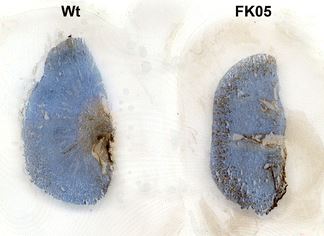 Ladislav Kuchar, Helena Faltyskova, Lukas Krasny, Robert Dobrovolny, Helena Hulkova, Jana Ledvinova, Michael Volny, Martin Strohalm, Karel Lemr, Lenka Kryspinov1, Befekadu Asfaw, Jitka Rybová, Robert J. Desnick and Vladimir Havlicek
Ladislav Kuchar, Helena Faltyskova, Lukas Krasny, Robert Dobrovolny, Helena Hulkova, Jana Ledvinova, Michael Volny, Martin Strohalm, Karel Lemr, Lenka Kryspinov1, Befekadu Asfaw, Jitka Rybová, Robert J. Desnick and Vladimir Havlicek
Anal Bioanal Chem. 2015 Mar; 407(8):2283-91. Epub 2014 Dec 27.
Fabry disease is an X-linked lysosomal storage disease due to deficient α-galactosidase A (α-Gal A) activity and the resultant lysosomal accumulation of globotriaosylceramide (Gb3) and related lipids primarily in blood vessels, kidney, heart, and other organs. The renal distribution of stored glycolipid species in the α-Gal A knockout mouse model was compared to that in mice to assess relative distribution and absolute amounts of accumulated sphingolipid isoforms. Twenty isoforms of five sphingolipid groups were visualized by mass spectrometry imaging (MSI), and their distribution was compared with immunohistochemical (IHC) staining of Gb3, the major stored glycosphingolipid in consecutive tissue sections. Quantitative bulk lipid analysis of tissue sections was assessed by electrospray ionization with tandem mass spectrometry (ESI-MS/MS). In contrast to the findings in wild-type mice, all three analytical techniques (MSI, IHC, and ESI-MS/MS) revealed increases in Gb3 isoforms and ceramide dihexosides (composed mostly of galabiosylceramides), respectively. To our knowledge, this is the first report of the distribution of individual molecular species of Gb3 and galabiosylceramides in kidney sections in Fabry disease mouse. In addition, the spatial distribution of ceramides, ceramide monohexosides, and sphingomyelin forms in renal tissue is presented and discussed in the context of their biosynthesis.


No responses yet